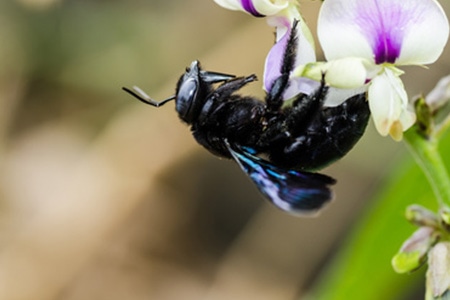Managing Bothersome Carpenter Bees
It's the season of bothersome carpenter bees. Learn more about these pests and how to control them.

Has this ever happened to you: you’re out on your back deck enjoying a refreshing glass of iced tea when a fat bee emerges from a hole in your woodwork and buzzes away? Carpenter bees are a common household nuisance. These docile insects are virtually harmless to humans but can cause serious damage to wooden structures.
Unlike termites, which actually consume wood, carpenter bees simply burrow into wood to build their nests. They also use the wood shavings left over from their excavation to build partitions in their nests.
How Do You Tell A Carpenter Bee from a Bumblebee?
It’s easy to recognize carpenter bees. They’re about the same size and shape as bumble bees, but while bumblebees’ bodies are covered in bright yellow hairs, carpenter bees’ bodies are slick, black, and shiny.
When Are They Most Active?
Carpenter bees are most active during the late spring and early summer when they’re searching for mates and nesting sites. Their preferred habitat is in softwoods such as redwood, cedar, cypress, and pine. In addition to trees, favored nesting sites include eaves, facia, window trim, clapboard siding, decks, and patio furniture.
Once they’ve found a favorable site, carpenter bees tunnel into the wood to lay their eggs. Their entry holes are easily identifiable because they are perfectly round and about a half an inch in diameter. Often, fresh sawdust can be seen near their entrances.
Male carpenter bees can be intimidating, sometimes even swarming people that get too close to their nests. Because they don’t have stingers, though, they’re completely harmless. Females do possess stingers but are very reluctant to use them except when in direct danger.
Pest Control
While carpenter bees are capable of causing extensive property damage if left unchecked, there are some simple strategies for repelling them.
The easiest way to deal with them is to prevent them from moving in in the first place. One of the most effective strategies for keeping them at bay is by ensuring that the wood on your property in good repair, as they are more likely to target unpainted or weathered wood. Make a habit of regularly painting all outdoor wood surfaces.
If they do move in, you can sometimes scare them off with loud noise. The insects are sensitive to noise, and simply placing a loud radio next to their nests may be enough to encourage them to move on.
Carpenter bees also dislike citrus oil. You can make your own safe and natural carpenter bee repellant by cutting up a variety of citrus peels and boiling them. Then pour the water into a spray bottle and douse their nest with it. Reapply frequently until you are sure that all of the bees have moved on.
Once you’re sure you’ve repelled the carpenter bees in a particular nest, including larvae, you can seal off their holes with caulk. Then paint or seal the affected area to prevent future infestations.

Jaime McLeod
Jaime McLeod is a longtime journalist who has written for a wide variety of newspapers, magazines, and websites, including MTV.com. She enjoys the outdoors, growing and eating organic food, and is interested in all aspects of natural wellness.






Carpenter bees are nectar robbers, mostly drilling through the back of the corolla, normally avoiding the sexual parts of the flower. So, not a great pollinator.
Hi Daniel, we’re not sure where you got that information. Robbin Thorp, the emeritus professor of entomology at UC Davis, is a staunch advocate of carpenter bees as effective pollinators so that might be a wive’s tale of some sort. Our beekeeping freelance writer confirms this information.
Carpenter bees bite. I learned this the hard way when I inadvertently got too close to their nest. Dude got me right on the side of my face. It smarted, too.
We have been bothered by them for years —this year I took a brown paper bag and stuffed it with plastic bags,then hung it on our deck and have only seen 1 or 2 bees all summer. They think its a hornets nest and avoid the area.
That was porch and carport by the way
We have quite a few in our porch and carpet. While they make me nervous they don’t bother me if I leave them alone. I do worry about my dogs however. My spaniel loves chasing bugs. When I was young I had a young spaniel that was stung to death by hundreds of them. My dad tried to save her and ended up sung also. A younger spaniel we had also was stung at the time. He ended up sick but recovered. Poor Cupcake didn’t make it. We had to wait until they went away before we could recover her body. So be aware and watch your pets around these bees. They can be very aggressive if provoked.
There is an additive that you can add to your wood sealer that deters them Z
WHAT ADDITIVE DO I USE TO WOOD SEALER
Measure their holes, take scrap wood, drill holes that size and put up near where they are nesting. When they leave the holes they use, plug it with a dowel rod and they will naturally go to the wood you fixed for them. Thus keeps your damage to a minimum and still provides them homes to reproduce.
I have a honey Bee tree just outside my yard, it is small tree with a hole just above ground level. I do not disturb it nor allow it to be disturbed. I have been told that there is a very large colony In a cave type area on the south end of my place that I have not seen due to the rough wild area where it is located. The fence builder had to wait for cold weather to complete the fence near this area. Pesticides are the worst enemy of all bees and especially honey bees that are trucked in to pollenate crops that may have been sprayed with a harmful pesticide. Amil Baker
I just leave them alone, if any holes; I fill them with wood putty.
Carpenter bees are pollinators and should not be killed.
I have found that a 5gallon paint stick works well to play B-Ball.When I was a kid I would shot them with a BB gun.Fun!
Great article, I just leave them along. If any damage is caused by them, I’ll just repair it.
Shame on you for suggesting that we kill any bees. Bees are seriously in decline & necessary for food production!
I have found a fly swatter to be very effective. ; )